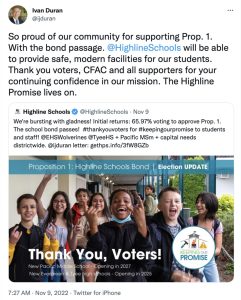| By Ben Winston
The Strategies 360 team is proud to have supported both Highline Public Schools and Renton School District in shaping their communication and outreach to the public before their successful bond measures were approved by voters in the Nov. 8 election. Our work for both districts began with robust public opinion research to inform the districts’ understanding of their communities. Our polling captured community sentiment in a way that closely aligned with bond measure performance in each district.
In this post, we explore how Strategies 360’s surveys helped guide the districts’ communications:
- Soliciting feedback. A central goal of public opinion research is gathering residents’ feedback on school district performance – both in terms of general satisfaction and on specific metrics such as class sizes, facility conditions, and teaching quality. These questions help districts understand community perceptions of their performance – and, as importantly, what efforts they may need to focus on more in their outreach throughout the year, not just during a campaign.
- Understanding priorities. Opinion surveys also help districts understand where their communities want school funding to go: do residents prioritize academic programs, mental health counselors, capital improvements, and/or extracurriculars, for example? These findings can help districts explain how funding measures would address needs across the community.
- Reaching the community. Surveys can assess where (or if) residents hear from or about the school district. Are parents hearing from their child’s schools? Are seniors receiving the district’s community newsletter? To what degree are national news stories about education impacting views of local districts? What modes of communication can districts use to reach the widest cross-section of residents?
- Funding challenges. Surveys on behalf of public school districts can measure general perceptions of a school district’s funding and budget condition and assess how residents consider their local property taxes relative to the quality of public schools in their area. These questions offer valuable insight into how a community might consider a funding measure.
- Demographic differences. Not all residents think about public education in the same way, nor do they receive information about schools from the same sources. Polls are invaluable to assessing demographic and geographic differences in attitudes, priorities, and beliefs. Do students in low-income households receive enough technological support? Do residents of one neighborhood of the district feel disconnected? Do residents of different ideological backgrounds agree on funding priorities?
Strategies 360 conducted opinion surveys for Renton SD and Highline PS in the spring and summer of 2022 which addressed these questions and more, and directly contributed to the districts’ successful communication strategies. In a Seattle Times story published just before the election, both districts framed their funding needs using poll-tested statements.
Congratulations to both districts on the successful passage of their school funding measures last week

The Strategies 360 Education team works with school districts across the state of Washington to help prepare for school funding measures. The Strategies 360 Research team has conducted over 50 surveys on behalf of these districts, as well as dozens more for school districts in other Western states. Please reach out to us at EdTeam@strategies360.com and research@strategies360.com for more information. |